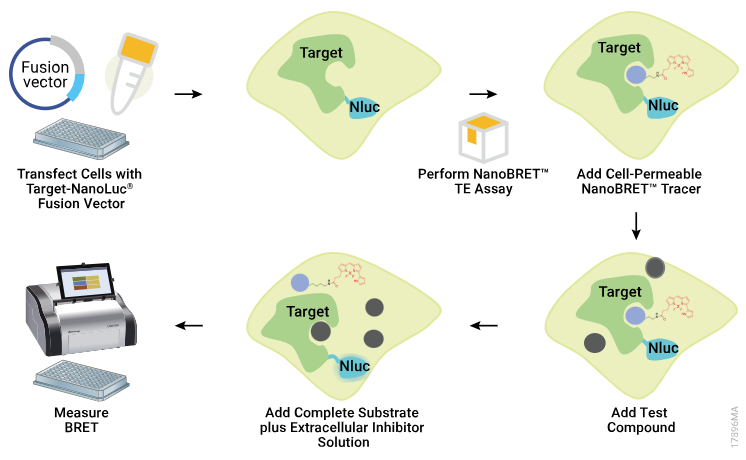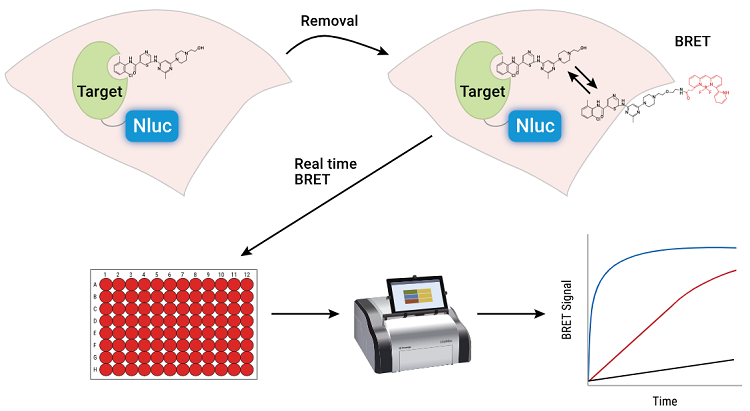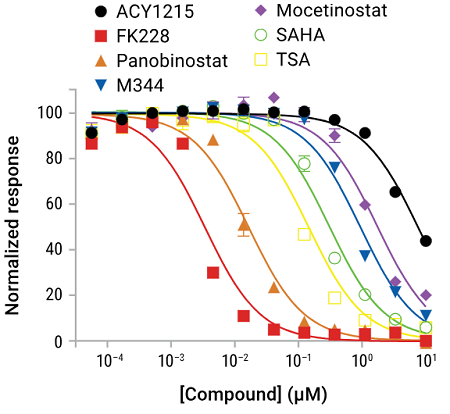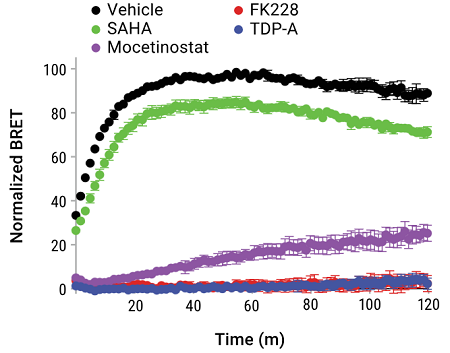Establishing that a molecule engages with its intended target protein in cells is an essential step in drug discovery and chemical probe development.
The NanoBRET™ Target Engagement assay platform from
Promega Corporation employs bioluminescence resonance energy transfer to quantify target occupancy, compound affinity, residence duration, and permeability in real-time in live cells. NanoLuc® luciferase is the enzyme at the core of this platform.
What is NanoBRET™ Target Engagement?
The term “target engagement” refers to a chemical compound’s interaction or binding with its target protein in a living system. Target engagement assays are required at various different stages of drug development, including target validation, establishing structure-activity relationships, and confirming mechanism of action (MOA).
An overview of NanoBRET™ technology and its application for target engagement assays. Video Credit: Promega Corporation
The NanoBRET™ Target Engagement assay, a brand-new live-cell binding assay, was created by Promega. It measures the binding of the target protein to tiny molecules in live cells using a method known as bioluminescence resonance energy transfer (BRET).
This energy transfer is based on two elements: Cellular expression of the target protein fused to NanoLuc® luciferase and a cell-permeable fluorescent NanoBRET™ tracer, which binds reversibly to the target protein.
Advantages of NanoBRET™ TE assays:
- With more than 360 ready-to-use assays for various target classes, such as kinases, E3 ligases, HDACs, bromodomains, RAS, PARP, and many more proteins, users can get started right away
- Utilizing the NanoBRET™ TE Do-It-Yourself Tools, users can create a NanoBRET™ TE assay for their protein of interest
- Target-specific assays, thanks to the tight distance constraints of BRET
- Compatible with multiple cell types
NanoBRET™ Target Engagement (TE) assays can:
- Measure target protein occupancy (the amount of a compound that binds to a protein) and compound affinity (how firmly a compound binds to a protein) in live cells
- Analyze a compound’s residence time, which measures how long it binds to the target protein under physiological circumstances
- Calculate cellular compound permeability
- Create accurate data that is highly reproducible and error-free
How does the NanoBRET™ TE assay work?
The target protein is expressed as a NanoLuc® luciferase fusion. A cell-permeable fluorescent NanoBRET™ tracer is then added, which reversibly binds to the target protein.
When the fluorescent tracer binds to the target-NanoLuc® fusion protein in live cells, the tracer is close to NanoLuc® luciferase and thus results in a BRET signal. Test compounds that bind to the target protein compete with the tracer and result in the loss of NanoBRET™ signal.

Image Credit: Promega Corporation
Quantitate affinity and occupancy
Unlike other cellular target engagement assays, NanoBRET™ TE assays can be used to determine intracellular compound affinity, not just potency. Utilizing a suitable NanoBRET™ Tracer concentration that is less than or equal to Tracer Kd allows for quantitative affinity measurements.
The suggested Tracer concentration, in addition to the NanoBRET™ Tracer Kd, is given for each target-specific NanoBRET™ TE assay created by Promega.
NanoBRET™ TE is also quantifiable in terms of partial occupancy. The BRET ratio can be translated to occupancy using the relevant experimental controls. The use of fractional occupancy enables the quantification of drug selectivity over a wide range of targets, such as kinases.
Determine residence time
NanoBRET™ Target Engagement Assays have the unique ability to analyze compound residence time in live cells. This quantification involves using cells expressing the target-NanoLuc® fusion protein and equilibrating them with a near-saturating concentration of compound. Next, unbound compound is removed and cells are treated with a near-saturating concentration of tracer.
The binding is followed kinetically such that compounds with slow dissociation kinetics from the target impede tracer binding, which slows production of the BRET signal. The real-time monitoring of binding kinetics and drug-target residence time in live cells is enabled by fast-binding NanoBRET™ tracers and the long signal half-Life for NanoLuc® luciferase.

An example of one method for measuring compound residence time using NanoBRET™ technology. Image Credit: Promega Corporation
The NanoBRET™ TE HDAC1 Assay was used in a study looking at isozyme-specific engagement and binding kinetics for a histone deacetylase (HDAC) inhibitor panel. According to the study’s findings:
- Despite its lower equilibrium binding affinity, mocetinostat exhibits better durable binding (residence time) than SAHA
- The clinically licensed HDAC prodrug FK228 and the comparable natural substance thailandepsin A (TDP-A) have very slow dissociation rates from HDAC1. This prolonged residence period shows that the previously described protracted phenotypic impact is caused by these powerful inhibitor-HDAC complexes

Correlation of phenotypic potency with target engagement to intracellular HDAC isozymes. Treatment with HDAC inhibitors for 48 hours results in antiproliferative effects in HeLa cells, as measured by intracellular ATP levels. Image Credit: Promega Corporation

Measuring the intracellular residence time of HDAC inhibitors at HDAC1. Measuring compound affinity under equilibrium conditions is one aspect of a live-cell NanoBRET™ TE assays. By incorporating residence time analysis, new insights are obtained. Image Credit: Promega Corporation
Design own target engagement assay
The NanoBRET™ Target Engagement technology can be used for a variety of target proteins, including kinases, HDACs, bromodomains, and GPCRs. If there is no NanoBRET™ TE Assay for the target of interest, users can design one.
Two essential decisions must be made: (1) a fluorescent tracer capable of binding the target protein and (2) a vector expressing a fusion of the target protein with NanoLuc® luciferase.
If the target protein is intracellular, the assay will require both the NanoBRET™ Nano-Glo® Substrate and the Extracellular NanoLuc® Inhibitor. These elements will ensure that the BRET signal measured by users is the consequence of intracellular interactions.

Image Credit: Promega Corporation
NanoBRET™ 590 Dyes are available from Promega for the synthesis of novel fluorescent tracers and the development of NanoBRET™ TE Assays against new targets.